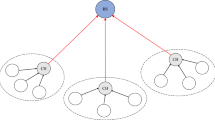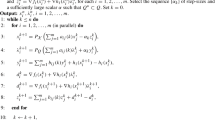Abstract
We address the bodyguard allocation problem (BAP), an optimization problem that illustrates the conflict of interest between two classes of processes with contradictory preferences within a distributed system. While a class of processes prefers to minimize its distance to a particular process called the root, the other class prefers to maximize it; at the same time, all the processes seek to build a communication spanning tree with the maximum social welfare. The two state-of-the-art algorithms for this problem always guarantee the generation of a spanning tree that satisfies a condition of Nash equilibrium in the system; however, such a tree does not necessarily produce the maximum social welfare. In this paper, we propose a two-player coalition cooperative scheme for BAP, which allows some processes to perturb or break a Nash equilibrium to find another one with a better social welfare. By using this cooperative scheme, we propose a new algorithm called FFC-BAPS for BAP. We present both theoretical and empirical analyses which show that this algorithm produces better quality approximate solutions than former algorithms for BAP.
Similar content being viewed by others
References
Tanenbaum A S, van Steen M. Distributed Systems: Principles and Paradigms (2nd edition). Prentice-Hall, Inc., 2006.
Nisan N, Roughgarden T, Tardos É, Vazirani V V. Algorithmic Game Theory. Cambridge University Press, 2007.
Halpern J Y. Beyond Nash equilibrium: Solution concepts for the 21st century. In Proc. the 27th ACM Symp. Principles of Distributed Computing, August 2008.
Manshaei M H, Zhu Q Y, Alpcan T, Bacşar T, Hubaux J P. Game theory meets network security and privacy. ACM Computing Surveys, 2013, 45(3): Article No. 25.
Feldman M, Lai K, Stoica I, Chuang J. Robust incentive techniques for peer-to-peer networks. In Proc. the 5th ACM Conf. Electronic Commerce, May 2004, pp.102-111.
Feldman M, Papadimitriou C, Chuang J, Stoica I. Freeriding and whitewashing in peer-to-peer systems. IEEE Journal on Selected Areas in Communications, 2006, 24(5): 1010-1019.
Roughgarden T. Selfish Routing and the Price of Anarchy. The MIT Press, 2005.
Koutsoupias E, Papadimitriou C. Worst-case equilibria. Computer Science Review, 2009, 3(2): 65-69.
von Neumann J, Morgenstern O. Theory of Games and Economic Behavior. Princeton University Press, 2007.
Fajardo-Delgado D, Fernández-Zepeda J A, Bourgeois A G. The bodyguard allocation problem. IEEE Trans. Parallel and Distributed Systems, 2013, 24(7): 1465-1478.
Nash J F Jr. Equilibrium points in n-person games. Proceedings of the National Academy of Sciences of the United States of America, 1950, 36(1): 48-49.
Dasgupta A, Ghosh S, Tixeuil S. Selfish stabilization. In Stabilization, Safety, and Security of Distributed Systems, Datta A K, Datta M (eds.), Springer, 2006, pp.231-243.
Cohen J, Dasgupta A, Ghosh S, Tixeuil S. An exercise in selfish stabilization. ACM Trans. Autonomous and Adaptive Systems, 2008, 3(4): Article No. 15.
Zatarain-Aceves H, Fernández-Zepeda J A, Brizuela C A, Fajardo-Delgado D. A cascade evolutionary algorithm for the bodyguard allocation problem. Applied Soft Computing, 2015, 37: 643-651.
Raidl G R, Julstrom B A. Edge sets: An effective evolutionary coding of spanning trees. IEEE Trans. Evolutionary Computation, 2003, 7(3): 225-239.
Barabási A L, Albert R. Emergence of scaling in random networks. Science, 1999, 286(5439): 509-512.
Erdös P, Rényi A. On the evolution of random graphs. Publ. Math. Inst. Hung. Acad. Sci., 1960, 5: 17-61.
Kumar R, Raghavan P, Rajagopalan S, Sivakumar D, Tomkins A, Upfal E. Stochastic models for the web graph. In Proc. the 41st Annual Symp. Foundations of Computer Science, November 2000, pp.57-65.
Schulz A S, Moses N S. On the performance of user equilibria in traffic networks. In Proc. the 14th Annual ACMSIAM Symp. Discrete Algorithms, January 2003, pp.86-87.
Anshelevich E, Dasgupta A, Kleinberg J, Tardos E, Wexler T, Roughgarden T. The price of stability for network design with fair cost allocation. In Proc. the 45th Annual IEEE Symp. Foundations of Computer Science, October 2004, pp.295-304.
Blum C, Roli A. Metaheuristics in combinatorial optimization: Overview and conceptual comparison. ACM Computing Surveys, 2003, 35(3): 268-308.
Eiben A E, Jelasity M. A critical note on experimental research methodology in EC. In Proc. Congress on Evolutionary Computation, May 2002, pp.582-587.
Črepinšek M, Liu S H, Mernik M. Replication and comparison of computational experiments in applied evolutionary computing: Common pitfalls and guidelines to avoid them. Applied Soft Computing, 2014, 19: 161-170.
Lilliefors H W. On the Kolmogorov-Smirnov test for normality with mean and variance unknown. Journal of the American Statistical Association, 1967, 62(318): 399-402.
Conover WJ. Practical Nonparametric Statistics.Wiley Series in Probability and Statistics, John Wiley & Sons, 1980.
Author information
Authors and Affiliations
Corresponding author
Electronic supplementary material
Below is the link to the electronic supplementary material.
Esm 1
(PDF 863 kb)
Rights and permissions
About this article
Cite this article
Fernández-Zepeda, J.A., Brubeck-Salcedo, D., Fajardo-Delgado, D. et al. A Two-Player Coalition Cooperative Scheme for the Bodyguard Allocation Problem. J. Comput. Sci. Technol. 33, 823–837 (2018). https://doi.org/10.1007/s11390-018-1858-8
Received:
Revised:
Published:
Issue Date:
DOI: https://doi.org/10.1007/s11390-018-1858-8




